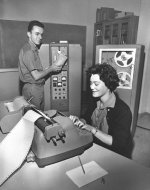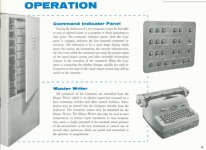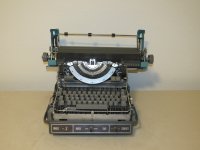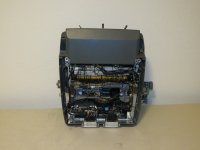stephenbuck
Experienced Member
A sub-thread of Bendix G-15 Restoration
I'm starting with the what I'm calling the typewriter console, also known as the "Master Writer", since it's easily transported, fairly light and relatively robust compared to the fragile vacuum-tube CPU and magnetic tape mechanisms. I live in the mountains at the end of a long, bumpy dirt road and the thought of all those tubes and mechanisms bouncing around in a truck led me to find some spare office space down on the flatlands for most of the restoration, but I can work on the console at home.
The console is an interesting part of the system in that it's based on an early IBM electric typewriter. Electric typewriters were often modified for use as input / output devices for early mainframes and minicomputers. The most commonly modified typewriters were made by IBM. In the 1950s, modified standard versions of the IBM Electric A, B, and C models were used as console typewriters or terminals on many early computers (e.g., GE 225, JOHNNIAC, IBM 650, IBM 1620, PDP-1). The IBM Selectric typewriter, introduced in 1961, was easier to interface to a computer and was favored in new designs, such as the IBM 1130 computer and the IBM 1050 terminal.
Here's the blog page where I'm summarize the conversations: Bendix G-15: Typewriter Console
I'm starting with the what I'm calling the typewriter console, also known as the "Master Writer", since it's easily transported, fairly light and relatively robust compared to the fragile vacuum-tube CPU and magnetic tape mechanisms. I live in the mountains at the end of a long, bumpy dirt road and the thought of all those tubes and mechanisms bouncing around in a truck led me to find some spare office space down on the flatlands for most of the restoration, but I can work on the console at home.
The console is an interesting part of the system in that it's based on an early IBM electric typewriter. Electric typewriters were often modified for use as input / output devices for early mainframes and minicomputers. The most commonly modified typewriters were made by IBM. In the 1950s, modified standard versions of the IBM Electric A, B, and C models were used as console typewriters or terminals on many early computers (e.g., GE 225, JOHNNIAC, IBM 650, IBM 1620, PDP-1). The IBM Selectric typewriter, introduced in 1961, was easier to interface to a computer and was favored in new designs, such as the IBM 1130 computer and the IBM 1050 terminal.
Here's the blog page where I'm summarize the conversations: Bendix G-15: Typewriter Console
Attachments
Last edited:






